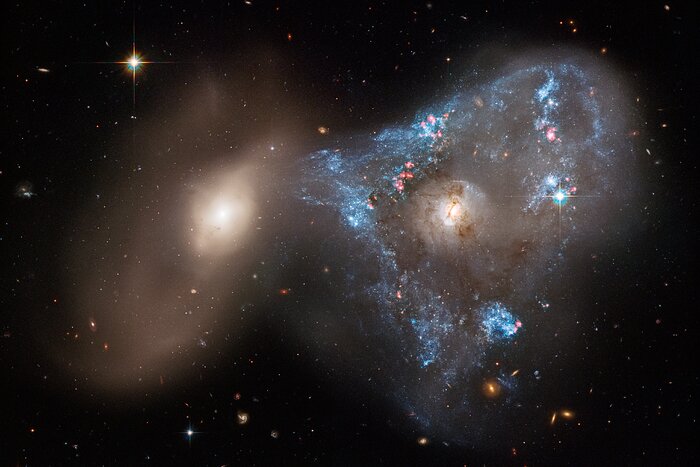Hubble Looks at a ‘Space Triangle’ Spawned by a Galaxy Collision
A spectacular head-on collision between two galaxies, known as Arp 143, has fueled the unusual triangular-shaped star-formation frenzy as captured by the NASA/ESA Hubble Space Telescope.
The interacting galaxy duo Arp 143 contains the distorted, star-forming spiral galaxy NGC 2445, at right, along with its less flashy companion, NGC 2444, at left. Their frenzied collision takes place against the tapestry of distant galaxies, of which some can be seen through the interacting pair.
Astronomers suggest that the two galaxies passed through each other, igniting the uniquely shaped firestorm of star formation in NGC 2445, where thousands of stars are bursting into life. This galaxy is awash with new stars because it is rich in gas, the raw material from which stars are made. However, it hasn’t yet escaped the gravitational clutches of its partner at left. The pair is waging a cosmic tug-of-war, which NGC 2444 appears to be winning. That galaxy has pulled gas from NGC 2445, forming the oddball triangle of newly minted stars.
NGC 2444 is also responsible for yanking strands of gas from its partner, stoking the streamers of young, blue stars that appear to form a bridge between the two galaxies. These streamers are among the first in what appears to be a wave of star formation that started on the galaxy’s outskirts and continued inward. Researchers estimate the streamer stars were born between 50 million and 100 million years ago. But these infant stars are being left behind as NGC 2445 continues to pull slowly away from NGC 2444.
Stars no older than one million to two million years old are forming closer to the centre of NGC 2445. Hubble’s keen vision reveals some individual stars, the brightest and most massive in the galaxy. Most of the brilliant blue clumps are groupings of stars and the pink blobs are glowing gas clouds enshrouding young, massive star clusters.
Although most of the action is happening in NGC 2445, it doesn’t mean the other member of the interacting pair has escaped unscathed. The gravitational tussle has stretched NGC 2444 into an odd shape, yanking gas far from the galaxy. NGC 2444 contains old stars and no new starbirth because it lost its gas long ago, well before this galactic encounter.
Aside from the star formation in NGC 2445, another interesting feature that Hubble has uncovered is the dark filaments of gas in the starburst galaxy’s bright core. Those features may have been formed by outbursts of material. Radio observations reveal a powerful source in the core that may be spearheading the outbursts. The radio source may have been produced by intense star formation or a black hole gobbling up material flowing into the centre.
It’s not uncommon for star formation to occur in the cores of galaxies, driven by interactions. Plenty of gas from galactic encounters flows into the centre, which can trigger the birth of new stars. Outflows from these stars can drive material out, but the dust created by these outbursts blankets the core and other regions throughout NGC 2445, making it difficult for Hubble to study in visible light.
However, the NASA/ESA/CSA James Webb Space Telescope will have the infrared vision to peer through the dust covering these regions to reveal the young star clusters that are hidden from view in visible-light images. In this way, Hubble and Webb will provide the full census of stars in NGC 2445. The census will help astronomers answer questions such as what the star-formation rate is, how long it takes for stars to form, and whether the starburst in NGC 2445 is fading or just heating up.
Studying young, massive star clusters still embedded in their dust and gas cocoons is important for understanding how star formation affects the evolution of galaxies. Massive stars that explode as supernovae enrich their environment with chemical elements heavier than hydrogen and helium.
The Arp 143 system is listed in a compendium of 338 unusual-looking interacting galaxies called the “Atlas of Peculiar Galaxies” published in 1966 by astronomer Halton Arp.
Hubble’s Observation of Arp 143
Wide-Field View of Arp 143
Zoom into Arp 143
A spectacular head-on collision between two galaxies has been captured by the NASA/ESA Hubble Space Telescope, which has the unusual triangular-shaped star-birthing frenzy.
The interacting galaxy duo is collectively called Arp 143. The pair contains the distorted, star-forming spiral galaxy NGC 2445, at right, along with its less flashy companion, NGC 2444, at left. This frenzied action takes place against the tapestry of distant galaxies. Some of them can be seen through the interacting pair.
Credit:NASA, ESA, STScI, and J. Dalcanton (Center for Computational Astrophysics/Flatiron Inst., UWashington)
Pan of Arp 143
A spectacular head-on collision between two galaxies has been captured by the NASA/ESA Hubble Space Telescope, which has the unusual triangular-shaped star-birthing frenzy.
The interacting galaxy duo is collectively called Arp 143. The pair contains the distorted, star-forming spiral galaxy NGC 2445, at right, along with its less flashy companion, NGC 2444, at left. This frenzied action takes place against the tapestry of distant galaxies. Some of them can be seen through the interacting pair.
Credit:NASA, ESA, STScI, and J. Dalcanton (Center for Computational Astrophysics/Flatiron Inst., UWashington)
Fuente: ESA/Hubble Information Centre




Comentarios